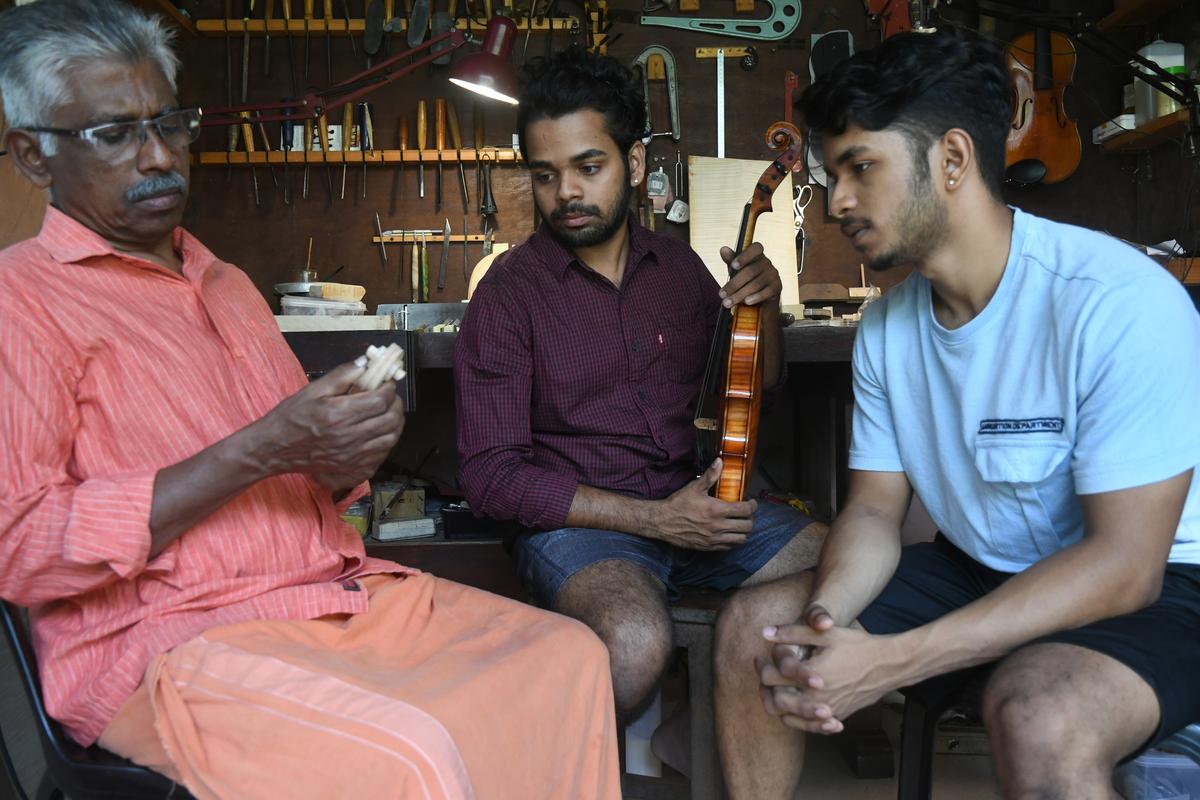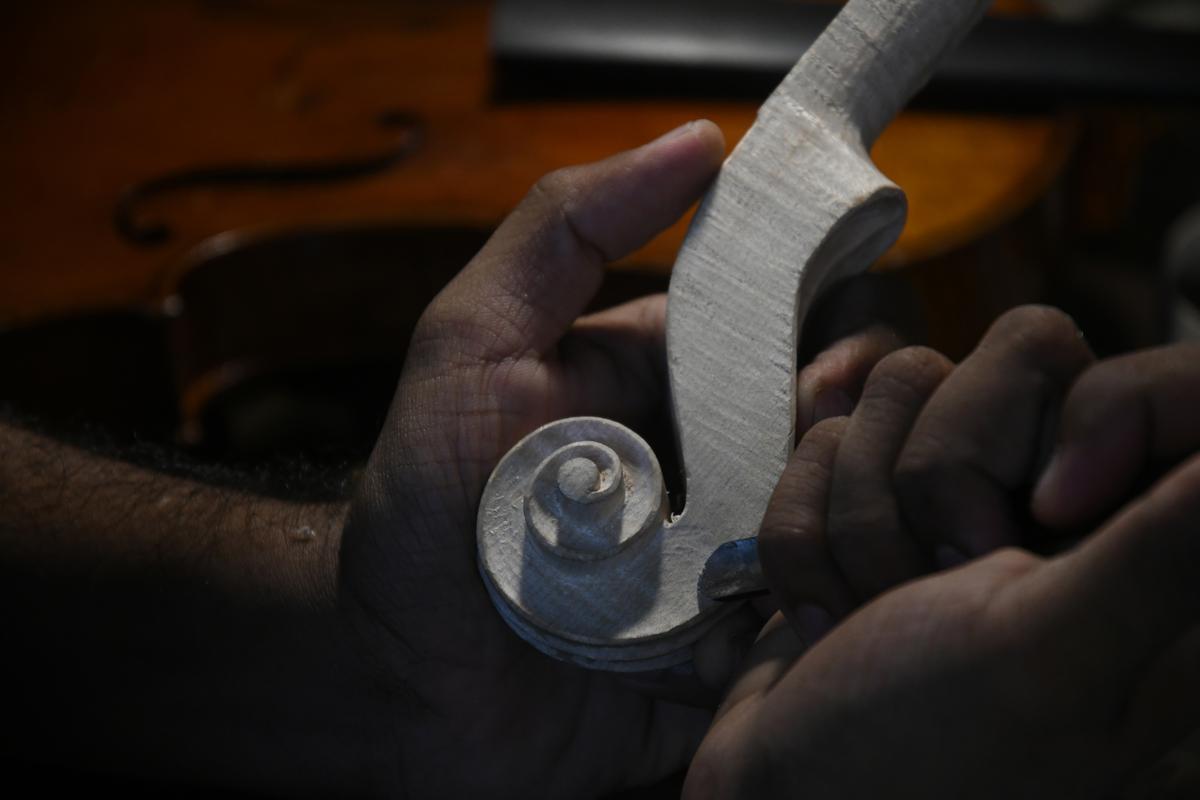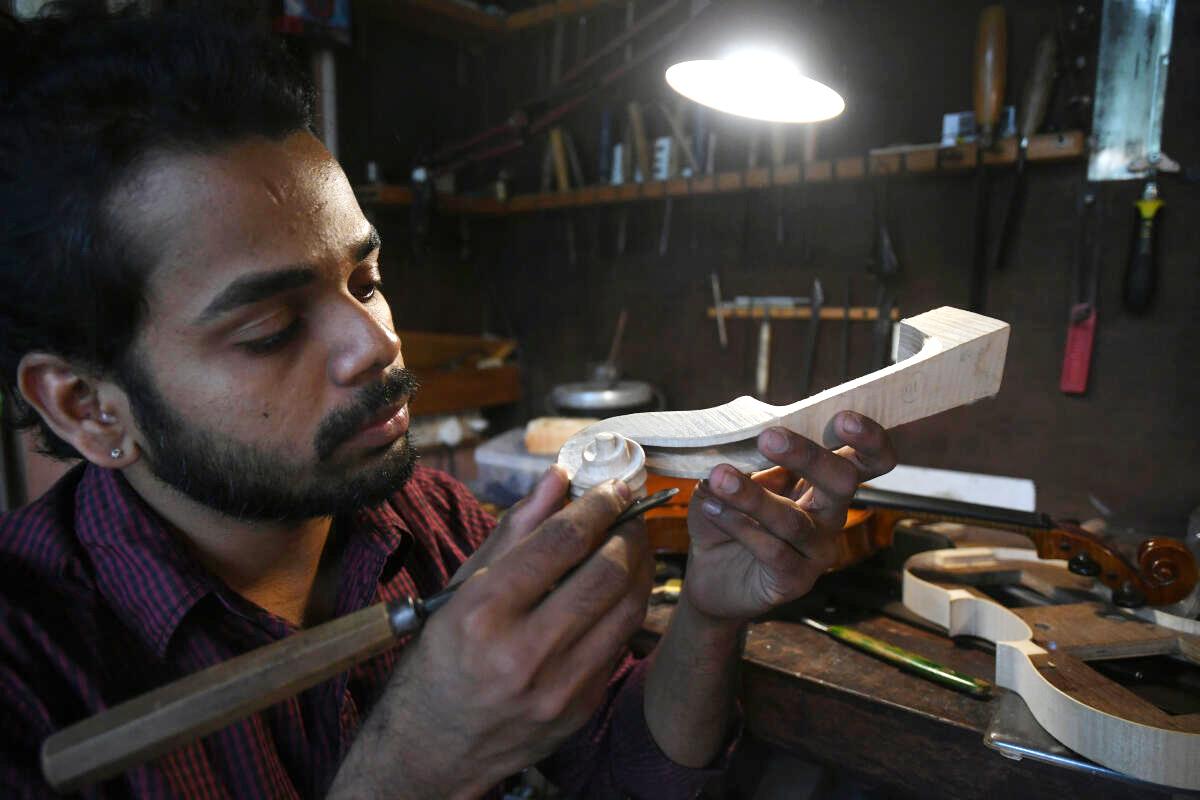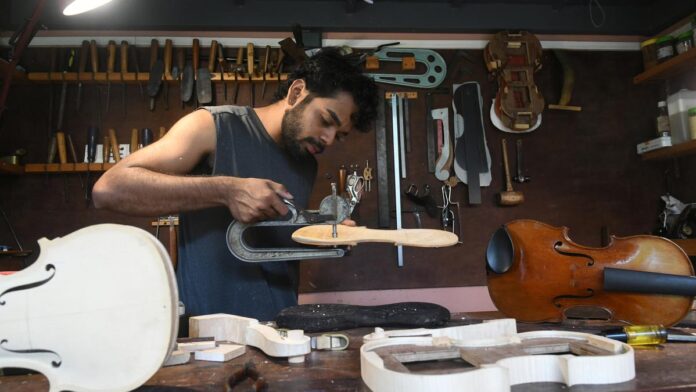Tucked away in a quiet part of Chendamangalam near Kochi in Kerala, is a tiny, barely-100 square foot workshop. Its longest wall is lined with tools and violins in various stages of production. The work table is littered with scales, tapes, and other measuring tools besides brass planers of multiple sizes, a container of glue and a file of measurement posters of violins. On the floor are pieces of wood that Vinay Murali, his father Murali ED, and younger brother Vijay, handcraft into violins.
The smallness of the space is misleading, the violins made here cost ₹1.5 lakh and more. Each of these has found musicians across India. For instance, Kumaresh of the violinist duo Ganesh-Kumaresh, and Edappally Ajith Kumar use the violins made by the family. All the instruments are made using mostly natural materials including glue and varnish. The strings and the tailpiece are the only parts that he sources elsewhere.
Tinkering
Although the family started making these high-end violins seven years ago, Vinay has been making and repairing violins and guitars since the early 1980s. “A friend and I learnt to play the violin and the guitar respectively in 1980. One day, he gave me his violin to repair and that is how my tryst with violins started. Over the years, one violin led me to the next and the next…” says Murali.
They are a musical family, he adds. Vinay and Vijay have formally learnt to play the violin. Murali, their father, who learnt the guitar at Cochin Arts and Communication (CAC), is a self-taught violin player too.

Murali with Vinay and Vijay
| Photo Credit:
Thulasi Kakkat
“It helps if you know how to play the violin, just like how knowing how to drive helps a car mechanic,” chimes Vinay strumming the violin.
When Murali started making violins, he made them using locally available, cheaper varieties of wood. Today though, three kinds of seasoned wood are used to make a violin — spruce, alpine maple and ebony. While spruce and alpine maple are imported from Germany, ebony is sourced locally as India and Sri Lanka are among the major exporters of ebony. Spruce is used for the soundboard and maple for the other parts. Ebony, a wood that is hard is limited to the finger-board and neck of the instrument because it is most prone to wearing off.
The wood is seasoned for at least 15 years and is done in two ways: it is dried naturally or kiln dried in a temperature-controlled environment. Since Vinay was once a carpenter, it is easy to figure out the nuances of the instrument, he says.

Critical moments
A turning point in the journey came in 2013 when Murali attended Violin Wise, a series of workshops organised by the Chennai-based Lalgudi Foundation. The two-week programme was an opportunity for Indian luthiers, to work with one of the world’s foremost violin makers — James Wimmer, from the US.
Murali was among the 14 participants. Wimmer, now in his 80s, came almost every year subsequently, the last workshop in 2022. “By the last year there were four participants from India. Wimmer was picky about who could attend,” Murali says.
The workshops widened their knowledge and gave them access to techniques and resources. “The violins we make are on a par with the ones made in Europe,” Vinay insists. Antonio Stradivari and Giuseppe Guarneri del Gesu are two 17th-Century Italian violin makers best known for the instruments they crafted. “The difference between the two is the shape — the Guarneri is curvier than the Stradivarius. We make both, but we get more orders for the Stradivarius-shaped ones,” he adds. Although the process is the same as it is in Europe, he says that they say encounter prejudice.
A violin is customised on the basis of whether the user is a Western classical violinist or a Carnatic musician. The former has four strings while the latter has five: some Carnatic musicians prefer their violin’s neck to be extended as they are seated on the ground [for concerts] and need to rest the violin on their leg while they play it.

“It is ergonomic. The traditional violin would give them cervical and spinal problems, lengthening the neck does not affect the instrument’s tonal quality,” Murali says. The weight of a violin has to be between 450-475 gram, Vinay says.
Since these are based on orders, there is no fixed number that they make at a given time. Each instrument takes 250-300 hours to make, “at times we are working on five or six simultaneously as each would be at a different stage of making,” Vinay says.
The glue is natural, derived from the bones and skin of animals and the varnish, which is tree sap cooked in vegetable oil, is prepared at home by Vinay. Synthetic glue or varnish would damage the wood, hardening it and making it difficult to service or repair. “The violin doesn’t need heavy-duty glue, just enough adhesive to hold the parts together. An advantage of natural glue is that it’s easy to take the instrument apart, nothing happens to the wood,” he explains.
They also restore violins, which include fixing broken violin parts using wood closest to the original. Vinay pulls out a German-made 1927 violin that has been brought for repair, it is one of the few that has a label. “Usually they are without labels and a violin lasts three or four generations. But I think we have worked on ones, sent to us from across the country, that are about 200 years old,” he says.
Their clientele is built around word-of-mouth publicity. Since the violins are high-end, retailing is not an option as these are also custom-made. “Someone looking to buy musical instruments from a shop is not looking for something that is this expensive or exclusive. More importantly, we don’t ‘manufacture’ in bulk… we cannot!” says Vinay.
He can be reached on Instagram @fiddle_crafter_luthiers
#Vinay #Murali #Kerala #handful #luthiers #India #handcrafts #violins
